Sublime truth, exalted art
"For some years now, Dr. Knölge had spent each spring and early summer
in one of the numerous hospitable vegetarian boarding houses on Lago Maggiore. In
these places he made the acquaintance of many different people and became accustomed
to sundry things, to long-haired apostles and walking barefoot, to fanatics and nutritional
gourmands. There were vegetarians, vegans, frugivores, and those favouring a macrobiotic
diet or a mixed diet. In the everyday language of the initiated, the doctor himself
belonged to the mixed-diet group."
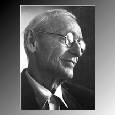 In 1907, the author Hermann Hesse underwent a protracted cure for alcoholism
on Monte Verità during which time he made friends with vegetarians and artists
who had been living there for many years. Much of Hesse's later fiction is set against
the backdrop of this enchanted hilltop in Ticino.
In 1907, the author Hermann Hesse underwent a protracted cure for alcoholism
on Monte Verità during which time he made friends with vegetarians and artists
who had been living there for many years. Much of Hesse's later fiction is set against
the backdrop of this enchanted hilltop in Ticino.
Similar to the Londoner Bloomsbury group or the Worpswede group in northern Germany
- and later also the Bauhaus movement in Dessau – artists of every ilk gathered on
Monte Verità to draw inspiration from the emanation of a parallel world.
The golden age of Monte Verità between 1900 and 1940 can be divided into
several eras: the anarchists (Erich Mühsam, Gustav Landauer, Raphael Friedeberg,
the psychotherapist Otto Gross) were succeeded by the vegetarian movement (the feminist
and pianist Ida Hofmann, Henri Oedenkoven, the brothers Karl and Gusto Gräser),
which was then followed primarily by Dadaists and Expressionists of every persuasion.
Eventually, the scientist Olga Froebe-Kapteyn initiated the Eranos Conferences.
A veritable 'return to nature' in the form of a countermovement was established
as an alternative to the rapid industrialisation in Europe at the close of the 19th
century. Between the turn of the century and the Second World War, Monte Verità
became a cultivation ground for unconventional art and life styles.
Between 1926 and 1958, some 35,000 visitors from Switzerland and abroad paid a
short visit to or even settled in this flourishing artistic Mecca above Ascona. The
natives of Ticino regarded these illustrious, oftentimes eccentric pilgrims as a
congregation of madmen. In order to improve his somewhat precarious financial situation,
Henri Oedenkoven, owner of Monte Verità for many years, charged admission
to the hilltop. For a fee, the locals could watch spa guests dining on legumes and
cereals.
In addition to vegetarians, pacifists, nudists, Freemasons, feminists, Theosophists
and bohemians many artists and writers were also attracted to the cultural health
food ambience on Monte Verità, coming in droves as life-style tourists for
shorter or longer stays.
With few exceptions, they were all famous in their own right before visiting Monte
Verità, having created their greatest works elsewhere. Although no lasting
and distinctive art form came into being on Monte Verità, the influence of
this offbeat resort in southern Switzerland is reflected in nearly every individual
work of fiction or art created during this period.
The evolution of German interpretational dance did, however, begin on Monte Verità:
Dancing spellbound on a lofty stage
 Rudolf von Laban founded a new dance art form. He wanted to break free
from the doctrines of traditional ballet and also break the bounds of dance as such.
His innovative theory of movement, the choral festivals and the inception of dance
therapy emerged (famous acolytes included Mary Wigman and Martha Graham, the later
originator of modern dance).
Rudolf von Laban founded a new dance art form. He wanted to break free
from the doctrines of traditional ballet and also break the bounds of dance as such.
His innovative theory of movement, the choral festivals and the inception of dance
therapy emerged (famous acolytes included Mary Wigman and Martha Graham, the later
originator of modern dance).
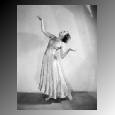 The canon of von Laban's movement specified dance as a fundamentally
essential part of life and education, a defining principle which endeavoured to express
a sense of naturalness and corporeality in a pervasive atmosphere of advancing civilisation.
Thus, during the strenuous 'work therapy programmes' vegetables for the guests were
peeled, diced and sliced to the accompaniment of dance steps. Von Laban's pupils
took breaks from the exertion of physical exercise by dancing eurhythmy.
The canon of von Laban's movement specified dance as a fundamentally
essential part of life and education, a defining principle which endeavoured to express
a sense of naturalness and corporeality in a pervasive atmosphere of advancing civilisation.
Thus, during the strenuous 'work therapy programmes' vegetables for the guests were
peeled, diced and sliced to the accompaniment of dance steps. Von Laban's pupils
took breaks from the exertion of physical exercise by dancing eurhythmy.
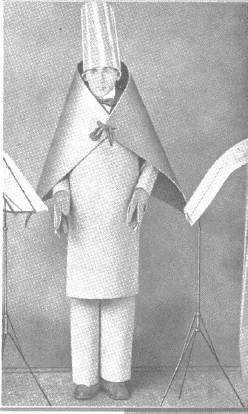 Monte Verità was significant
for the development of both the Cabaret Voltaire and the Dada movement, as witnessed
by the 'emigrants' from Germany to Zurich (Hugo Ball, Emmy Hennings, Iwan and Claire
Goll, Klabund, Tristan Tzara, Oskar Schlemmer, Hans Richter, among many others).
In winter, Rudolf von Laban held dance classes in Zurich and in summer on Monte Verità.
The relationship between von Laban and his dancers and the artists of the Dada movement
evolved on different levels. For example, the dancers took part in Dadaist activities
in Zurich by reciting poems by Arp or Ball in the Cabaret Voltaire. In the summer
months, they all joined the Dadaists on Monte Verità where various happenings
took place (choral festivals, choreographed verse recitals, masquerades, etc.).
Monte Verità was significant
for the development of both the Cabaret Voltaire and the Dada movement, as witnessed
by the 'emigrants' from Germany to Zurich (Hugo Ball, Emmy Hennings, Iwan and Claire
Goll, Klabund, Tristan Tzara, Oskar Schlemmer, Hans Richter, among many others).
In winter, Rudolf von Laban held dance classes in Zurich and in summer on Monte Verità.
The relationship between von Laban and his dancers and the artists of the Dada movement
evolved on different levels. For example, the dancers took part in Dadaist activities
in Zurich by reciting poems by Arp or Ball in the Cabaret Voltaire. In the summer
months, they all joined the Dadaists on Monte Verità where various happenings
took place (choral festivals, choreographed verse recitals, masquerades, etc.).
Claire Goll wrote: "L’atmosphère de Zurich n’inicitait pas au travail.
Trop d’amis, trop de sollicitations, une vie de café passionnante mais superficielle.
Ascone était un monastère ou dans le calme et sous un ciel tranquille,
le travail était facile."
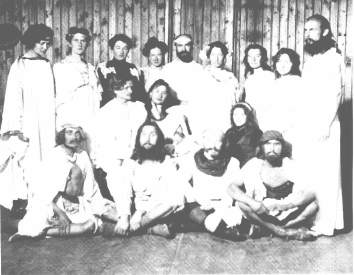 Artists from Berlin, Munich
and other major German cities came to Monte Verità either because they had
clashed with the law (Ball, Hennings), or because they regarded Switzerland as a
sanctuary, and southern Switzerland as the fount of enlightenment.
Artists from Berlin, Munich
and other major German cities came to Monte Verità either because they had
clashed with the law (Ball, Hennings), or because they regarded Switzerland as a
sanctuary, and southern Switzerland as the fount of enlightenment.
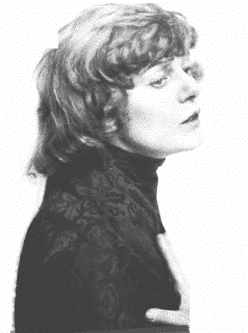 In the pursuit of an idyll,
Ball and Hennings settled permanently in Ticino at the end of the 1920s. After Ball's
death, Emmy Hennings's financial situation deteriorated to the extent that she became
dependent primarily on the support of Hermann Hesse, who was then living in nearby
Montagnola.
In the pursuit of an idyll,
Ball and Hennings settled permanently in Ticino at the end of the 1920s. After Ball's
death, Emmy Hennings's financial situation deteriorated to the extent that she became
dependent primarily on the support of Hermann Hesse, who was then living in nearby
Montagnola.
Expressionistic utopia
In July 1919, Friedrich Glauser, a writer from the German-speaking part of Switzerland,
ran away from the Münsingen Psychiatric Hospital near Bern where he had been
interned for treatment of morphine addiction. "It seemed extraordinary, being
totally free. And yet I couldn't shake off this gnawing fear."
In Ascona, he met the painter and former pharmacist Marianne Werefkin as well
as Hugo Ball and Emmy Hennings. Glauser was a follower of Dadaism and was wont to
make an appearance reciting verse. His morphine habit attracted the attention of
a pharmacist in Ascona who secured Glauser's readmittance to the mental hospital.
Looking back on the time in Ascona, Glauser wrote, "I learned a lot there, however
not so much from the people themselves, although they weren't completely without
their influence on me. Perhaps the most meaningful thing was the insight that creativity
shouldn't be overrated, and that man as the source of this creativity most particularly
shouldn't be overrated. Because that which we are only ineffectually capable of expressing
in words and in pictures isn't a product of our own volition. Creativity is a gift
and should be cherished as such. We have no right to be overproud of our talents.
But vanity is, unfortunately, very widespread."
Other Swiss Expressionists who visited Monte Verità included: Hans Arp,
Sophie Taeuber, Hans Morgenthaler, Fritz Pauli, Robert Schürch and the puppet
player Jakob Flach.
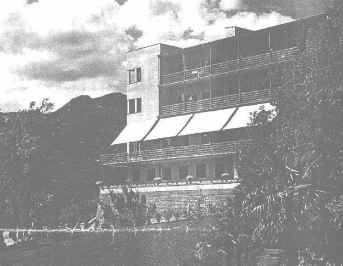 Bauhaus artists from Berlin
and Dessau described Monte Verità and the art and life style reformist philosophy
practised there as a "parallel" world, a haven in a menacing national socialist
environment (Breuer, Albers, Bayer, etc.). The architect Emil Fahrenkamp built the
Albergo Monte Verità in the incomparably rational Bauhaus style. Shortly thereafter,
the bibliophilic volume of pictures entitled Ascona-Baubuch was published
(with typographic art by Max Bill).
Bauhaus artists from Berlin
and Dessau described Monte Verità and the art and life style reformist philosophy
practised there as a "parallel" world, a haven in a menacing national socialist
environment (Breuer, Albers, Bayer, etc.). The architect Emil Fahrenkamp built the
Albergo Monte Verità in the incomparably rational Bauhaus style. Shortly thereafter,
the bibliophilic volume of pictures entitled Ascona-Baubuch was published
(with typographic art by Max Bill).
Some of the literary guests from Germany were Gerhart Hauptmann, Else Lasker-Schüler,
Emil Ludwig, Erich Maria Remarque, René Schickele, Albert Ehrenstein, Franziska
Gräfin zu Reventlow, the advocate of women's emancipation, and Heinrich Vogeler
from Worpswede.
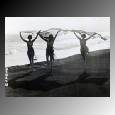 One of the finest Expressionists of the 20th century, Marianne
von Werefkin, lived for many years in Ascona before her death and was held in exceptionally
high esteem by the locals – an honour bestowed on very few, because the residents
of Ticino generally looked askance at the incomprehensible and slightly lunatic activities
on Monte Verità. The entire population of Ascona paid tribute to Marianne
von Werefkin on the day of her funeral in February 1938. She bequeathed the majority
of her works to the community of Ascona; these are today exhibited in the Museo communale.
One of the finest Expressionists of the 20th century, Marianne
von Werefkin, lived for many years in Ascona before her death and was held in exceptionally
high esteem by the locals – an honour bestowed on very few, because the residents
of Ticino generally looked askance at the incomprehensible and slightly lunatic activities
on Monte Verità. The entire population of Ascona paid tribute to Marianne
von Werefkin on the day of her funeral in February 1938. She bequeathed the majority
of her works to the community of Ascona; these are today exhibited in the Museo communale.
Among the many other Expressionist painters who visited Monte Verità were:
Alexey von Jawlensky, Arthur Segal, Annette Kolb and Louis Moilliet.
In 1978, Harald Szemann organised a large-scale retrospective exhibition entitled
Der Hang zum Gesamtkunstwerk (Penchant for a Synthesis of the Arts) on the
art and life styles of Monte Verità. The exhibition later went on tour to
Zurich, Munich and Vienna.
Today, the remaining, renovated buildings (including the luminous air lodge) are
primarily used for conferences.
Woe betide the visitor, tired and in need of nourishment after a particularly
arduous day, who may be foolish enough to snack on a ham sandwich under a leafy tree
in the expansive grounds of Monte Verità. Danger lurks in the form of the
savage primordial vegetarian!
"Hardly had Knölge decided to leave the provinces the following month
and return home when he felt oddly compelled to walk near the small wood by the radiant
light of the full moon. His thoughts turned back to bygone days when, in the best
of health, he lived as an ordinary mortal and meat-eater among his fellowmen. Absorbed
in these wistful memories of happy times, he absentmindedly began to whistle an old
fraternity song.
Suddenly, enraged by the tune and brandishing a mighty club, a sylvan thrashed
through the underbrush to stand directly in front of the stroller. Bowing, with a
fierce and sneering smile and mocking voice, it said: Allow me to introduce myself,
Dr. Knölge.
The gorilla dropped its club and with a howl of fury pounced on Knölge, strangling
him instantly with its dreadful hands. He was found the next morning. Some guessed
what had happened, but no one dared interfere with the great ape Jonas, who sat calmly
on a branch peeling nuts. The few friends the stranger had made during his sojourn
in paradise buried him close by and put a plain marker on his grave with the brief
inscription: Dr. Knölge from Germany, mixed-diet visitor." (excerpt from
Hermann Hesse: Weltverbesserer, suhrkamp 1985)
Christine Eggenberg, February 9th 2000
Translated from German by Barbara Zach-Miller, April 25th 2000
You can download this text (pdf-file)
back to conference page
7.11.2000/niba
 In 1907, the author Hermann Hesse underwent a protracted cure for alcoholism
on Monte Verità during which time he made friends with vegetarians and artists
who had been living there for many years. Much of Hesse's later fiction is set against
the backdrop of this enchanted hilltop in Ticino.
In 1907, the author Hermann Hesse underwent a protracted cure for alcoholism
on Monte Verità during which time he made friends with vegetarians and artists
who had been living there for many years. Much of Hesse's later fiction is set against
the backdrop of this enchanted hilltop in Ticino. Rudolf von Laban founded a new dance art form. He wanted to break free
from the doctrines of traditional ballet and also break the bounds of dance as such.
His innovative theory of movement, the choral festivals and the inception of dance
therapy emerged (famous acolytes included Mary Wigman and Martha Graham, the later
originator of modern dance).
Rudolf von Laban founded a new dance art form. He wanted to break free
from the doctrines of traditional ballet and also break the bounds of dance as such.
His innovative theory of movement, the choral festivals and the inception of dance
therapy emerged (famous acolytes included Mary Wigman and Martha Graham, the later
originator of modern dance). The canon of von Laban's movement specified dance as a fundamentally
essential part of life and education, a defining principle which endeavoured to express
a sense of naturalness and corporeality in a pervasive atmosphere of advancing civilisation.
Thus, during the strenuous 'work therapy programmes' vegetables for the guests were
peeled, diced and sliced to the accompaniment of dance steps. Von Laban's pupils
took breaks from the exertion of physical exercise by dancing eurhythmy.
The canon of von Laban's movement specified dance as a fundamentally
essential part of life and education, a defining principle which endeavoured to express
a sense of naturalness and corporeality in a pervasive atmosphere of advancing civilisation.
Thus, during the strenuous 'work therapy programmes' vegetables for the guests were
peeled, diced and sliced to the accompaniment of dance steps. Von Laban's pupils
took breaks from the exertion of physical exercise by dancing eurhythmy.



 One of the finest Expressionists of the 20th century, Marianne
von Werefkin, lived for many years in Ascona before her death and was held in exceptionally
high esteem by the locals – an honour bestowed on very few, because the residents
of Ticino generally looked askance at the incomprehensible and slightly lunatic activities
on Monte Verità. The entire population of Ascona paid tribute to Marianne
von Werefkin on the day of her funeral in February 1938. She bequeathed the majority
of her works to the community of Ascona; these are today exhibited in the Museo communale.
One of the finest Expressionists of the 20th century, Marianne
von Werefkin, lived for many years in Ascona before her death and was held in exceptionally
high esteem by the locals – an honour bestowed on very few, because the residents
of Ticino generally looked askance at the incomprehensible and slightly lunatic activities
on Monte Verità. The entire population of Ascona paid tribute to Marianne
von Werefkin on the day of her funeral in February 1938. She bequeathed the majority
of her works to the community of Ascona; these are today exhibited in the Museo communale.